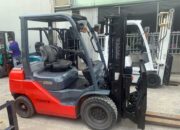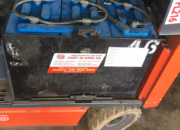Optimizing warehouse space with Reach Trucks
The explosion of e-commerce, supply chain development, and increased industrial output has led to a surge in demand for goods storage. Businesses face a challenging puzzle: how to optimize warehouse space and improve logistics efficiency without incurring excessive investment costs in expanding warehouse areas?
Among countless solutions, Reach Trucks have emerged as a “savior” for businesses. With their specialized design, ability to operate flexibly in narrow spaces, and outstanding performance, Reach Trucks are gradually replacing traditional forklifts, becoming the optimal choice for modern warehouses.
Reach Trucks: The optimal choice for warehouse space optimization
Reach Trucks are specifically designed to operate in narrow aisles, with the ability to lift and handle goods safely and efficiently at high elevations. So what makes Reach Trucks so special?
Ultra-compact design, optimized for every space:
The biggest difference between Reach Trucks and traditional counterbalance forklifts lies in their ultra-compact design. The minimized truck width allows for comfortable movement in narrow aisles, ranging from 2.5 to 3 meters. The extremely small turning radius enables flexible maneuvering, saving travel space.
Thanks to this design, Reach Trucks can operate effectively in warehouses with limited space, maximizing storage space without the need for warehouse expansion. Businesses can arrange more shelves, increase storage density, and enhance warehouse capacity.
Superior lifting and lowering capabilities conquer all heights:
Not only compact, Reach Trucks also possess outstanding lifting and lowering capabilities. The truck’s extending reach allows access to and handling of goods at high positions, making full use of vertical warehouse space. Some modern Reach Trucks can lift loads up to 12 meters, meeting the needs of high-rise warehouses.
This “tremendous” lifting capacity allows businesses to optimize the use of vertical space, increasing warehouse capacity without incurring additional investment costs in floor space.
Intelligent, safe, and efficient operating mechanism:
Reach Trucks are equipped with an intelligent operating mechanism that allows the lifting mast to move flexibly in multiple directions: extending, retracting, lifting, and lowering. This allows the truck to easily access goods in any position and perform complex handling operations in confined spaces safely and efficiently.
For example, a Reach Truck can easily retrieve goods from high-rise racks, place goods on deep pallets, and move goods through narrow aisles without any obstacles.
Outstanding benefits of applying Reach Trucks in warehouse management
The application of Reach Trucks brings many practical benefits to businesses, contributing to improving logistics efficiency and optimizing costs:
Increased operational productivity:
Fast travel speed and powerful lifting and lowering capabilities help shorten goods handling time and increase labor productivity.
Minimizes waiting time, accelerates import and export progress, and improves supply chain efficiency.
Cost savings for warehouse operations:
Reduces warehouse rental costs by optimizing storage space.
Saves labor costs by reducing the number of employees required for goods handling.
Minimizes goods damage, saving repair and replacement costs.
Ensuring occupational safety:
Equipped with modern safety systems: automatic braking system, overload warning, surveillance cameras… to help minimize the risk of occupational accidents.
Creates a safe and professional working environment, enhancing the image of the business.
Choosing a Reach Truck and factors to consider
To choose the right Reach Truck for your needs, businesses need to carefully consider the following factors:
Lifting capacity:
Clearly determine the weight of the goods to be lifted, the type of pallet used… to choose the type of forklift with a suitable load capacity for actual needs.
Calculate the excess lifting capacity to ensure safety and operational efficiency.
Lifting height:
Determine the height of the shelves in the warehouse and the height of the warehouse ceiling to choose a truck with a suitable lifting height.
Working environment:
Choose the type of vehicle suitable for the working environment: cold storage, normal warehouse, chemical warehouse…
Forklift brand and supplier:
Prioritize reputable and quality forklift brands with good warranty and maintenance regimes.
Choose an experienced and reputable supplier that provides attentive after-sales service.
In conclusion:
Reach Trucks are an effective solution for optimizing warehouse space, bringing many practical benefits to businesses. Choosing the right forklift for your needs and paying attention to important factors when purchasing will help businesses increase operational productivity, save costs, and ensure occupational safety.







